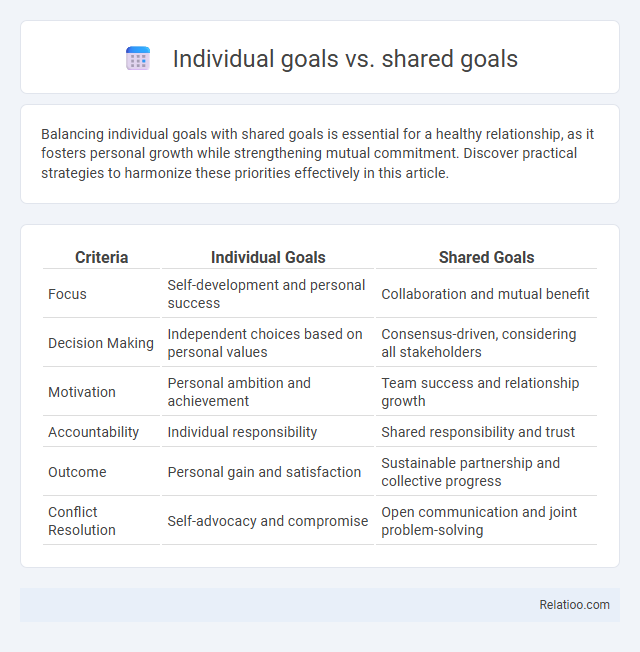Balancing individual goals with shared goals is essential for a healthy relationship, as it fosters personal growth while strengthening mutual commitment. Discover practical strategies to harmonize these priorities effectively in this article.
Table of Comparison
| Criteria | Individual Goals | Shared Goals |
|---|---|---|
| Focus | Self-development and personal success | Collaboration and mutual benefit |
| Decision Making | Independent choices based on personal values | Consensus-driven, considering all stakeholders |
| Motivation | Personal ambition and achievement | Team success and relationship growth |
| Accountability | Individual responsibility | Shared responsibility and trust |
| Outcome | Personal gain and satisfaction | Sustainable partnership and collective progress |
| Conflict Resolution | Self-advocacy and compromise | Open communication and joint problem-solving |
Understanding Individual Goals
Understanding individual goals involves recognizing personal motivations, aspirations, and performance targets that drive an individual's actions within a team or organization. Clarity in individual goals enhances focus, accountability, and alignment with broader team objectives while allowing for personalized growth and contribution. Effective communication ensures individual goals support shared goals and balance shared responsibility, fostering overall success.
Defining Shared Goals
Defining shared goals involves collaboratively establishing clear, specific, and measurable objectives that align the efforts of all team members toward a common purpose. These goals foster unity, enhance communication, and boost collective accountability by ensuring everyone understands their role in achieving the shared outcome. Emphasizing shared goals over individual goals encourages collaboration, reduces conflicts, and drives higher team performance through mutual support and synchronized actions.
Key Differences Between Individual and Shared Goals
Individual goals focus on personal achievement, measurable by your own progress and outcomes, while shared goals require collaborative effort and collective success among team members. Shared responsibility distributes tasks and accountability across all participants, fostering cooperation, unlike individual goals where accountability rests solely on you. The key difference lies in the scope of ownership and impact, with individual goals emphasizing self-driven motivation and shared goals promoting interdependence and unified purpose.
Benefits of Pursuing Individual Goals
Pursuing individual goals allows you to develop personal skills and enhance self-discipline, which fosters greater confidence and motivation. Achieving your own objectives can lead to a clearer sense of purpose and unique accomplishments that contribute to overall growth. While shared goals promote teamwork, focusing on individual goals builds the foundation necessary for meaningful collaboration and shared responsibility.
Advantages of Shared Goals in Teams
Shared goals in teams foster collaboration and enhance collective focus, driving higher productivity and innovation through aligned efforts. Your team benefits from increased motivation and accountability as members work towards a common objective, reducing conflicts and improving communication. Emphasizing shared goals cultivates a culture of trust and mutual support, essential for sustained success and team cohesion.
Challenges of Balancing Personal and Collective Goals
Balancing individual goals with shared goals and responsibilities often creates conflicts due to differing priorities and motivation levels among team members. Challenges arise when personal ambitions overshadow collective objectives, leading to reduced collaboration and potential resentment within the group. Effective communication, clear role definitions, and mutual accountability are essential to align personal aspirations with team success.
Strategies for Aligning Individual and Shared Objectives
Aligning individual goals with shared objectives requires clear communication of organizational priorities and the integration of personal performance metrics with team success indicators. Implementing collaborative goal-setting frameworks, such as OKRs (Objectives and Key Results), fosters transparency and accountability by linking individual contributions to collective outcomes. Regular feedback loops and adaptive planning ensure ongoing alignment, mitigating conflicts between personal ambitions and group responsibilities.
Impact on Motivation and Performance
Individual goals foster personal accountability and drive intrinsic motivation, often leading to high performance through clear, measurable outcomes. Shared goals enhance team cohesion and collective purpose, boosting motivation by aligning individual efforts toward a common objective and improving collaborative performance. Shared responsibility distributes tasks evenly across members, reinforcing mutual accountability, increasing engagement, and sustaining consistent performance across diverse team dynamics.
Case Studies: Successes and Failures
Case studies reveal that individual goals often lead to focused achievements, but shared goals align team efforts for greater overall success. Shared responsibility in these cases enhances accountability, fostering collaboration that mitigates failures observed when tasks are siloed. Your ability to balance personal objectives with collective accountability determines the effectiveness of goal execution in any project.
Best Practices for Goal Setting in Groups
Effective group goal setting involves clearly distinguishing between individual goals, shared goals, and shared responsibility to foster collaboration and accountability. Best practices include aligning individual objectives with the group's collective mission, ensuring all members understand their roles in achieving shared goals, and promoting transparent communication to track progress. Establishing measurable benchmarks and regular feedback loops enhances motivation and drives consistent team performance.

Infographic: Individual goals vs Shared goals
 relatioo.com
relatioo.com